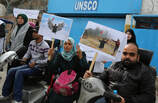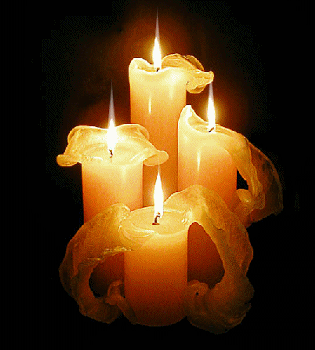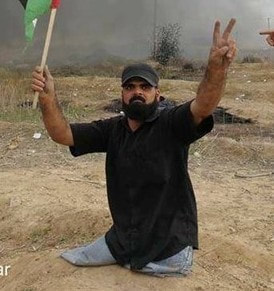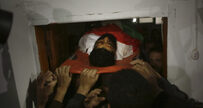17 may 2019

Palestinians with disabilities protest the killing of Ibrahim Abu Thurayya in front of UNESCO headquarters in Gaza City in December 2017
The Israeli military has closed its internal probe into the killing of Ibrahim Abu Thurayya during protests in the Gaza Strip in December 2017.
The military’s investigation of itself concluded that there was no evidence that Abu Thurayya was killed by direct Israeli fire.
Abu Thurayya was slain during protests against Donald Trump’s recognition of Jerusalem as the capital of Israel.
Eight Palestinians, including Abu Thurayya, would be killed during protests against Trump’s Jerusalem declaration that month.
Their deaths anticipated Israel’s brutal crackdown on unarmed demonstrations launched under the banner of the Great March of Return along Gaza’s eastern boundary a few months later.
More than 200 Palestinians have been killed during those demonstrations, and around 8,400 wounded by live fire.
At least one of those killed during the Great March of Return, 29-year-old Fadi Abu Salmi, was a double amputee, like Abu Thurayya. Both men had lost their legs during Israeli airstrikes years earlier.
Abu Salmi was shot in the chest while sitting in his wheelchair under a tree with friends during protests on 14 May 2018. A UN commission of inquiry found that Abu Salmi “did not pose an imminent threat of life or injury to [Israeli] soldiers at the time he was killed.”
Both Abu Salmi and Abu Thurayya were known to the Israeli army snipers on the other side of the boundary fence due to their distinctive injuries and regular participation in protests.
The human rights group B’Tselem stated that Abu Thurayya “would get out of his wheelchair, crawl toward the fence, then crawl away and get back into his wheelchair. He became a familiar figure to the soldiers.”
“Go away, Ibrahim”Two days before Abu Thurayya was shot in the head, according to witness testimony given to B’Tselem, an Arabic-speaking soldier using a bullhorn said,
“Go away, Ibrahim.”
The same witness told B’Tselem that Abu Thurayya would lift up his shirt “to show the soldiers that he wasn’t armed and that he posed no threat to anyone.”
Abu Thurayya was sitting in his wheelchair and holding a Palestinian flag “when he was shot in the forehead in what appears to have been a deliberate act of killing,” according to the human rights group Al-Haq.
“Under international humanitarian and human rights law, [Abu Thurayya] was entitled to special protection not only as a civilian under the control of the occupying power, but also as a person with disability who moreover lost his legs as a consequence of a prior assault by Israel on the Gaza Strip,” Al-Haq adds.
“The perspective of persons with disabilities must be taken into account in the assessment of whether certain conduct amounts to prohibited inhuman acts. As such, the killing of Ibrahim Abu Thurayya may not only amount to an arbitrary deprivation of life but also an act of torture or ill-treatment.”
The United Nations human rights chief at the time condemned Israel’s killing of Abu Thurayya, calling it “incomprehensible” and a “truly shocking and wanton act,” but stopped short of calling for any real accountability.
Disabled persons intentionally shotThe independent UN commission of inquiry formed after Israel killed 60 Palestinians during a single day of protests in May 2018 has found that occupation forces may have committed war crimes and crimes against humanity by using lethal military force against unarmed protesters in Gaza.
“[Israeli forces] have intentionally shot children, they’ve intentionally shot people with disabilities, they’ve intentionally shot journalists, knowing them to be children, people with disabilities and journalists,” Sara Hossain, one of the other three investigators appointed by the UN Human Rights Council, said.
Eight persons with a disability have been killed during the Great March of Return protests, according to Al Mezan, a human rights group in the Gaza Strip.
B’Tselem characterizes the Israeli military’s internal investigations as a “whitewash” mechanism. So long as it remains this way, the rights group says, “with no one being held account for these actions, the unlawful killing will continue.”
Lack of remedy
The Israeli military announced it had closed its investigation into Abu Thurayya’s death on 15 May, the annual Palestinian commemoration of the Nakba, and one year and a day after Israeli snipers massacred 60 Palestinians protesting in Gaza while officials celebrated the inauguration of the US embassy in Jerusalem.
In March this year, the UN Human Rights Council adopted the commission of inquiry’s findings that Israel’s use of lethal force against protesters warrants criminal investigation and prosecution.
The resolution notes the lack of meaningful Israeli investigations into human rights abuses by its forces, as well as the “numerous legal, procedural and practical obstacles in the Israeli civil and criminal legal system contributing to the denial of access to justice for Palestinian victims and of their right to an effective judicial remedy.”
The Israeli military has closed its internal probe into the killing of Ibrahim Abu Thurayya during protests in the Gaza Strip in December 2017.
The military’s investigation of itself concluded that there was no evidence that Abu Thurayya was killed by direct Israeli fire.
Abu Thurayya was slain during protests against Donald Trump’s recognition of Jerusalem as the capital of Israel.
Eight Palestinians, including Abu Thurayya, would be killed during protests against Trump’s Jerusalem declaration that month.
Their deaths anticipated Israel’s brutal crackdown on unarmed demonstrations launched under the banner of the Great March of Return along Gaza’s eastern boundary a few months later.
More than 200 Palestinians have been killed during those demonstrations, and around 8,400 wounded by live fire.
At least one of those killed during the Great March of Return, 29-year-old Fadi Abu Salmi, was a double amputee, like Abu Thurayya. Both men had lost their legs during Israeli airstrikes years earlier.
Abu Salmi was shot in the chest while sitting in his wheelchair under a tree with friends during protests on 14 May 2018. A UN commission of inquiry found that Abu Salmi “did not pose an imminent threat of life or injury to [Israeli] soldiers at the time he was killed.”
Both Abu Salmi and Abu Thurayya were known to the Israeli army snipers on the other side of the boundary fence due to their distinctive injuries and regular participation in protests.
The human rights group B’Tselem stated that Abu Thurayya “would get out of his wheelchair, crawl toward the fence, then crawl away and get back into his wheelchair. He became a familiar figure to the soldiers.”
“Go away, Ibrahim”Two days before Abu Thurayya was shot in the head, according to witness testimony given to B’Tselem, an Arabic-speaking soldier using a bullhorn said,
“Go away, Ibrahim.”
The same witness told B’Tselem that Abu Thurayya would lift up his shirt “to show the soldiers that he wasn’t armed and that he posed no threat to anyone.”
Abu Thurayya was sitting in his wheelchair and holding a Palestinian flag “when he was shot in the forehead in what appears to have been a deliberate act of killing,” according to the human rights group Al-Haq.
“Under international humanitarian and human rights law, [Abu Thurayya] was entitled to special protection not only as a civilian under the control of the occupying power, but also as a person with disability who moreover lost his legs as a consequence of a prior assault by Israel on the Gaza Strip,” Al-Haq adds.
“The perspective of persons with disabilities must be taken into account in the assessment of whether certain conduct amounts to prohibited inhuman acts. As such, the killing of Ibrahim Abu Thurayya may not only amount to an arbitrary deprivation of life but also an act of torture or ill-treatment.”
The United Nations human rights chief at the time condemned Israel’s killing of Abu Thurayya, calling it “incomprehensible” and a “truly shocking and wanton act,” but stopped short of calling for any real accountability.
Disabled persons intentionally shotThe independent UN commission of inquiry formed after Israel killed 60 Palestinians during a single day of protests in May 2018 has found that occupation forces may have committed war crimes and crimes against humanity by using lethal military force against unarmed protesters in Gaza.
“[Israeli forces] have intentionally shot children, they’ve intentionally shot people with disabilities, they’ve intentionally shot journalists, knowing them to be children, people with disabilities and journalists,” Sara Hossain, one of the other three investigators appointed by the UN Human Rights Council, said.
Eight persons with a disability have been killed during the Great March of Return protests, according to Al Mezan, a human rights group in the Gaza Strip.
B’Tselem characterizes the Israeli military’s internal investigations as a “whitewash” mechanism. So long as it remains this way, the rights group says, “with no one being held account for these actions, the unlawful killing will continue.”
Lack of remedy
The Israeli military announced it had closed its investigation into Abu Thurayya’s death on 15 May, the annual Palestinian commemoration of the Nakba, and one year and a day after Israeli snipers massacred 60 Palestinians protesting in Gaza while officials celebrated the inauguration of the US embassy in Jerusalem.
In March this year, the UN Human Rights Council adopted the commission of inquiry’s findings that Israel’s use of lethal force against protesters warrants criminal investigation and prosecution.
The resolution notes the lack of meaningful Israeli investigations into human rights abuses by its forces, as well as the “numerous legal, procedural and practical obstacles in the Israeli civil and criminal legal system contributing to the denial of access to justice for Palestinian victims and of their right to an effective judicial remedy.”
28 mar 2018
The Military Police investigation refutes the claim of Gazan officials and the UN High Commissioner for Human Rights, Zeid Ra’ad Al Hussein, who had almost immediately blamed Israel for killing the wheelchair-bound man. Hussein put out a strongly-worded statement, saying in part, “Given his severe disability, which must have been clearly visible to those who shot him, his killing is incomprehensible – a truly shocking and wanton act.”
But the two snipers from the Maglan special forces unit who had been in the area of the riot at the time and were questioned under caution in recent weeks firmly denied the claim.
“We are trained to accurately hit our targets,” one of the snipers told his investigators, according to the report. “And in any event, the instruction is to shoot at the lower part of a key instigator’s body. There’s no chance we killed him. We are trained to detect injuries after every shooting, and when that happens we see people gather around the wounded person. In this case, it didn’t happen.”
About 1,000 Palestinians had taken part in the violent disturbance near the Gazan fence, which had been called to protest US President Trump’s announcement earlier that month recognizing Jerusalem as the capital of Israel. Some hurled stones and Molotov cocktails as well as a pipe bomb, while others rolled burning tires at the fence.
The investigation found that snipers only fired three times that day at those identified as key instigators. For the most part, other, non-lethal crowd-dispersal means were used.
The report confirmed the results of the initial IDF investigation, which said that while it was “impossible” to determine what caused his death, “No live fire was aimed at Abu Thuraya.” An investigation on the division level had also discovered that Abu Thuraya, who was a common sight at similar protests, had visited his family on the night before the riot and told them goodbye, as he was intending to become a martyr.
Coordinator of Government Activities in the Territories (COGAT) Major General Yoav Mordechai called at the time for the Red Cross to obtain the medical records from the hospital to find out what had really happened to the disabled activist, stressing the importance of uncovering the truth.
“We have to put an end to the industry of rumors, exaggerations, and lies which incense public discourse and incite to violence,” Mordechai said.
But the two snipers from the Maglan special forces unit who had been in the area of the riot at the time and were questioned under caution in recent weeks firmly denied the claim.
“We are trained to accurately hit our targets,” one of the snipers told his investigators, according to the report. “And in any event, the instruction is to shoot at the lower part of a key instigator’s body. There’s no chance we killed him. We are trained to detect injuries after every shooting, and when that happens we see people gather around the wounded person. In this case, it didn’t happen.”
About 1,000 Palestinians had taken part in the violent disturbance near the Gazan fence, which had been called to protest US President Trump’s announcement earlier that month recognizing Jerusalem as the capital of Israel. Some hurled stones and Molotov cocktails as well as a pipe bomb, while others rolled burning tires at the fence.
The investigation found that snipers only fired three times that day at those identified as key instigators. For the most part, other, non-lethal crowd-dispersal means were used.
The report confirmed the results of the initial IDF investigation, which said that while it was “impossible” to determine what caused his death, “No live fire was aimed at Abu Thuraya.” An investigation on the division level had also discovered that Abu Thuraya, who was a common sight at similar protests, had visited his family on the night before the riot and told them goodbye, as he was intending to become a martyr.
Coordinator of Government Activities in the Territories (COGAT) Major General Yoav Mordechai called at the time for the Red Cross to obtain the medical records from the hospital to find out what had really happened to the disabled activist, stressing the importance of uncovering the truth.
“We have to put an end to the industry of rumors, exaggerations, and lies which incense public discourse and incite to violence,” Mordechai said.
Page: 2 - 1



